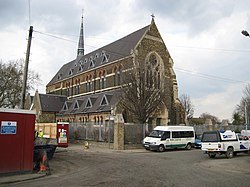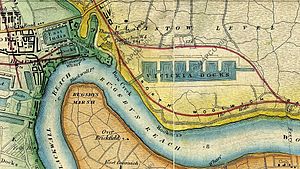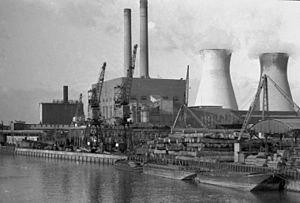Canning Town
| Canning Town | |
| Essex | |
|---|---|
 St Luke's Church, now used as a community centre | |
| Location | |
| Grid reference: | TQ4081 |
| Location: | 51°30’54"N, -0°1’34"E |
| Data | |
| Post town: | London |
| Postcode: | E16 |
| Dialling code: | 020 |
| Local Government | |
| Council: | Newham |
| Parliamentary constituency: |
West Ham |
Canning Town is a town in Essex, within the London metropolitan conurbation. It is situated between Plaistow to the north, Royal Victoria Dock to the south, Beckton to the east, and, across the River Lea in Middlesex, Poplar to the west.
The town was developed to house dock workers. It is among the most socially deprived in the country.
History


Prior to the 19th century, the district was largely marshland, and accessible only by boat, or a toll bridge. In 1809, an Act of Parliament was passed for the construction of the Barking Road between the East India Docks and Barking. A five span iron bridge was constructed in 1810 to carry the road across the River Lea at Bow Creek. This bridge was damaged by a collision with a collier in March 1887 and replaced by the London County Council (LCC) in 1896. This bridge was in turn replaced in 1934,[1] at a site to the north and today's concrete flyover begun in smaller form in the 1960s, but successively modified to incorporate new road layouts for the upgraded A13 road and a feeder to the Limehouse Link tunnel, avoiding the Blackwall Tunnel. The abutments of the old iron bridge have now been utilised for the Jubilee footbridge, linking the area to Leamouth on the western bank of the Lea.
The area is thought to be named after the first Viceroy of India, Charles John Canning, who suppressed the Indian Mutiny about the time the district expanded. The population increased rapidly after the North London Line was built from Stratford to North Woolwich, in 1846. This was built to carry coal and goods from the docks; and when the passenger station was first built it was known as Barking Road.[2] Speculative builders constructed houses for the workers attracted by the new chemical industries established in the lower reaches of the River Lea, and for the nearby Thames Ironworks and Shipbuilding Company and Tate & Lyle refinery.[3]
The opening of the Royal Victoria Dock in 1855 accelerated the development of the area[1] creating employment and a need to house dock workers and their families. New settlements around the dock developed, starting with Hallsville, Canning Town and Woolwich, and later the areas now known as [Custom House, Silvertown and West Silvertown. The new settlements lacked water supply and had no sewage system, leading to the spread of cholera and smallpox.[4] The casual nature of employment at the docks meant poverty and squalid living conditions for many residents,[3] and in 1857 Charles Dickens wrote about the area:
"Canning Town is the child of the Victoria Docks. The condition of this place and of its neighbour prevents the steadier class of mechanics from residing in it. They go from their work to Stratford or to Plaistow. Many select such a dwelling place because they are already debased below the point of enmity to filth; poorer labourers live there, because they cannot afford to go farther, and there become debased. The Dock Company is surely, to a very great extent, answerable for the condition of the town they are creating. Not a few of the houses in it are built by poor and ignorant men who have saved a few hundred pounds, and are deluded by the prospect of a fatally cheap building investment."[5]
The industries around the dock were often unhealthy and dangerous. As trade unions and political activists fought for better living conditions and the dock area became the centre of numerous movements with Will Thorne, James Keir Hardie and other later becoming leading figures in the Labour Party.[4] From the late 19th century, a large African mariner community was established in Canning Town as a result of new shipping links to the Caribbean and West Africa[6] In 1917 50 tons of TNT exploded at the Brunner Mond & Co ammunition work in Silvertown, causing the largest explosion in London's history and damaging more than 70,000 buildings and killing 73 people.[4]
In the 1930s the County Borough of West Ham commenced slum clearances.[3] New houses, clinics, nurseries and a lido were opened. Silvertown Bypass and Britain's first flyover, the Silvertown Way, were built along with other new approach roads to the docks. Canning Town was heavily hit by the bombings in World War II and Canning Town Council's plan to rebuild the area focused on a reduction of the population, transferring industry and the building of new housing such as the Keir Hardie Estate, which included schools and welfare services.[4] The slum clearances and the devastation of World War II, destroying 85% of the housing stock, led to the preponderance of council estates that characterise the area today.[3] Post-war housing schemes followed the urban planning principles of the garden city movement. As demand for housing grew the first high rise buildings were built in Canning Town in 1961. In 1968 Ronan Point, a 22-storey tower block in Newham, partially collapsed and most of the tall tower blocks built in the area in the early 1960s were eventually demolished or reduced in size.[4]
References
- ↑ 1.0 1.1 West Ham: Rivers, bridges, wharfs and docks, A History of the County of Essex: Volume 6 (1973), pp. 57-61 accessed: 29 May 2008
- ↑ West Ham: Transport and postal services, A History of the County of Essex: Volume 6 (1973), pp. 61-63 accessed: 16 January 2008.
- ↑ 3.0 3.1 3.2 3.3 West Ham: Domestic buildings, A History of the County of Essex: Volume 6 (1973), pp. 50-57 accessed: 17 January 2008.
- ↑ 4.0 4.1 4.2 4.3 4.4 "The Royal Docks – a short history". Royal Docks Trust. http://www.royaldockstrust.org.uk/rdhist.htm. Retrieved 28 June 2010.
- ↑ Charles Dickens Londoners over the Border, Household Words – Volume XVI (1857)
- ↑ Geoffrey Bell, The other Eastenders : Kamal Chunchie and West Ham's early black community (Stratford: Eastside Community Heritage, 2002)

This Essex article is a stub: help to improve Wikishire by building it up.